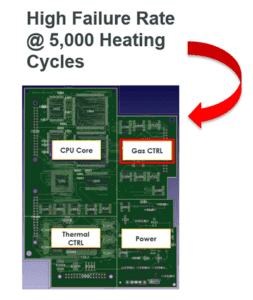I recently talked on predictive failure analysis at the PTC LiveWorx 2017 conference. There was a lot of audience interest, so I thought I’d share some of the things I discussed. This is the second of two posts on this subject.
In Part 1, I looked at the benefits of predictive failure analysis, along with a real world example using a typical home furnace. Now I’ll look at how you can move your product development process forward to take advantage of predictive failure analysis and, ultimately, improve your product quality? You may be surprised at how easily you can get game-changing benefits by making some design process changes and using proven technology…
Step 1: Switch from component-based design to function- or modular-based design
 Today, electronic hardware is typically designed by placing components on a schematic. Moving to a module or function-based design process has a number of benefits. Modular design alone enables reuse and faster design cycles. But combine modular design with a design data management (DDM) platform and the benefits expand to include ownership, history, version control, and where-used and user-defined data. It’s like supercharging it! If there is a problem with the module, a DDM system enables comprehensive problem resolution by identifying every product that uses it.
Today, electronic hardware is typically designed by placing components on a schematic. Moving to a module or function-based design process has a number of benefits. Modular design alone enables reuse and faster design cycles. But combine modular design with a design data management (DDM) platform and the benefits expand to include ownership, history, version control, and where-used and user-defined data. It’s like supercharging it! If there is a problem with the module, a DDM system enables comprehensive problem resolution by identifying every product that uses it.
Another key benefit is the notion of continuous improvement. The module owner can continually improve the quality (e.g. reliability, cost, manufacturability) and that change history is part of the module’s annotated data. The module’s annotated data also contains diagnostics that exercise the function and become part of the field diagnostics package. So if we stick with our example of the home furnace, it runs diagnostics on a module by module basis and reports back diagnostic codes that can identify the failures. Modular design is an emerging trend that should be considered with or without adoption of predictive failure analysis.
Step 2: Establish the IoT platform and the Cloud
This step goes beyond the scope of Zuken’s solutions and will require a partner. In this case, PTC offers an IoT Platform called ThingWorx®. The IoT platform provides the linkage between the device and the PLM system and, ultimately, to the design team via a design data management solution (e.g. DS-2).
In this case, the furnace runs diagnostics on a periodic basis and reports back the results and environmental conditions to the IoT platform, which is the collection point for the connected devices. It collects the data and runs analytics to determine if we have a failure trend that can be identified. We’re considering a manufacturer monitoring 500,000 furnaces, so let’s say the furnace population diagnostics indicate the gas control module on the furnace appears to be failing regularly at 5,000 heating cycles or about 4-5 years of usage, but it is designed for 20,000 heating cycles. The IoT platform is connected to the PLM system and that information is attached to the design record for this furnace model. If you have a design data management system connected to your PLM system, that gas control module performance record can be attached directly to the design module as annotated data. The design team now has everything they need to improve the quality of the gas control module.
Step 3: Device to Cloud Connection
As in step 2, I’m going to reference one of our partners to provide the device connectivity to the IoT platform. PTC’s Kepware® provides the communication channel for managing and monitoring your connected device. The furnace simply uses the Kepware connection to log diagnostics and environmental conditions to the cloud.
This is possible now!
The exciting part is that we can now measure the product performance in the hands of a customer, not just in the lab. Predictive failure analysis is attainable today. The pieces exist. But it does require a change in your design process from component-based to module-based design, which should be considered on its own merit. The IoT pieces are available and proven. Remember, the connected device has already been implemented and utilizes “Apps” that we all commonly use. We are just applying the same connectivity for the purpose of field performance measurement.
The opportunity exists now to measure and improve your product quality.
Related Content

- Broschüre

- Solutions

- Blog
I recently talked on predictive failure analysis at the PTC LiveWorx 2017 conference. There was a lot of audience interest, so I thought I’d share some of the things I discussed.





